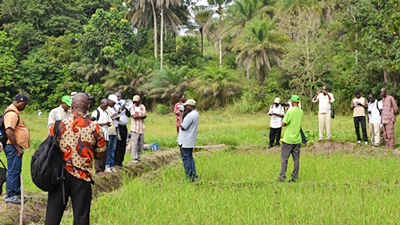Overview
The West Africa Agricultural Productivity Programme (WAAPP) is an initiative of the Economic Community of West African States (ECOWAS) financially facilitated by the World Bank to support regional cooperation in the agricultural sector, mainly in the area of agriculture research and extension which is a key pillar of the Comprehensive Africa Agricultural Development Programme (CAADP). Mandated by ECOWAS, the West and Central African Council for Agricultural Research and Development (CORAF/WECARD) takes the coordinating role to implement WAAPP. The development objective of WAAPP is therefore: to generate and accelerate the adoption of improved technologies in the participating countries’ top agricultural commodity priority areas that are aligned with the sub-region’s top agricultural commodity priorities outlined in the ECOWAS Agricultural Policy (ECOWAP). WAAPP is being implemented in 13 ECOWAS countries in two phases (of 5 years each) over a 10 year period. A specific support is provided under WAAPP by the Japan PHRD for the development of rice sector in the Mano River countries.
Challenge
Agriculture is one of the two priority sectors of the World Bank’s regional strategy. The agriculture sector provides the source of livelihoods for almost two-thirds of the population in the continent and therefore the Bank’s intervention in this sector would bring about high poverty reduction impact to the majority of the population, making it the key to one of our twin goals – shared prosperity.
Agriculture in Africa is ready for transformational change. Conditions are more conducive to agricultural development in Africa now than they have been in the past 40 years. Particularly, the recent trend of high international prices of the agricultural commodities has made the market more buoyant and the Bank estimates that the African agriculture sector could become a trillion dollar industry by 2030, up from US$330 billion as of today.
With a view to achieving this ambitious target, there are three main challenges that are closely linked to each other: low productivity; access issues in regional and international markets; and the threat of climate change. Among the three, low productivity is attributed to access to and adoption of appropriate agricultural technology and inputs together with various enabling factors. For instance, lack of human and financial resources and appropriate infrastructure is a major barrier to develop appropriate technologies in the national research system, as well as their dissemination by the extension services.
The Bank aims at halving the yield gap by 2025 through accelerating the adoption of such technologies and inputs while enhancing resilience to climatic shocks.
Approach of WAAPP
WAAPP tries to address these issues in three ways. Firstly, WAAPP accelerates the exchange of proven and ready-to-go agricultural technologies among the participating countries. It is true that one country has very little on the shelf but if combined at the regional level, there are quite a few. So WAAPP is unlocking the flow of information from one country to another so that each country has more to offer to the farmers.
One of the key features to this end is the so-called “National Center of Specialization (NCoS)” that is, to assign a commodity to a member country which concentrates the resource to the commodity while disseminating the results to other countries. As of today, there are nine NCoS in this sub-region for such crops as maize (Benin), rice (Mali), mangrove rice (Sierra Leone), dry land cereals (Senegal), plantain (Côte d’Ivoire), roots and tubers (Ghana), fruits and vegetables (Burkina Faso), aquaculture (Nigeria), livestock (Niger). While these centers of specialization will be upgraded to the centers of excellence, WAAPP is trying to allow faster and more efficient exchanges of technologies and genetic materials through harmonization of regulations and systems in each participating country.
Secondly, WAAPP is assisting each country to introduce systems to accelerate the delivery and adoption of the technologies at the national level. In doing so, the WAAPP work to facilitate collaboration among researchers, support services boards and universities to enable them to work in partnership with farmers, private sector and civil society to better respond to the needs and opportunities in a holistic manner. This is called “Innovation Platform” approach and it is another key feature of the programme.
Thirdly WAAPP is playing a key role in reviving/strengthening the seed systems in West Africa. This includes support to the implementation of regional common regulations on seeds, support to Governments to prepare seed strategies and strengthen seed certification systems, support to all stakeholders to scale up improved seeds availability.
In summary, WAAPP activities are categorized under the following three components.
- Component 1: Enabling conditions for sub-regional cooperation in the generation, dissemination and adoption of agricultural technologies;
- Component 2: National Centers of Specialization (NCoS) / strengthening of the research systems;
- Component 3: Support to demand-driven technology generation, dissemination and adoption (accelerated), improved genetic material;
The Japanese PHRD Fund for Mano River Union Member States
Support to the Mano River Union (MRU) Member States – Côte d’Ivoire, Guinea, Liberia and Sierra Leone – falls within the third series of the WAAPP Programme (WAAPP-1C) and started in May 2008, when the heads of MRU member states applied for their participation to the WAAPP. The MRU programme interventions are specifically dedicated to the development of rice and cassava cultivation, two crops that provide the basic foodstuffs to the overwhelming majority of the Populations in the MRU sub region. In the specific context of the MRU countries, support is also aimed at strengthening institutional mechanisms and procedures for integrating regional rice markets and cross-border/national dissemination of technologies.
The core programme elements are the same as described above with special consideration of the consequences of the conflicts within the MRU member states. Specific fundingamounting $ 35 million has been provided by a Japanese Policy and Human Resource Development (PHRD) grant for the MRU Members States to rebuild their adaptive research and technology transfer capacities specifically for rice, following the conclusion of the Fourth Tokyo International Conference for African Development (TICAD IV) in which the Government of Japan pledged its contribution to the development of the rice sector in Sub-Sahara Africa. The MRU Secretariat has been mandated by CORAF/WECARD to coordinate the Japanese grant activities.
Results in MRU countries
The programme in the MRU Member States started in early 2012 and the Mid-Term Review was conducted in March 2014. To date the key highlights of achievements of PHRD Grant projects are as follows.
Guinea. The project has been very active with notable progress made in various fronts. Key research facilities have been well rehabilitated and they have taken on seven research projects on plant breeding, fertilizer applications and production techniques. At the same time, technologies and rice varieties introduced from Mali, Sierra Leone and the Philippines have been released for dissemination. At the field level, improved equipment and training have been provided to about 2,500 female farmers for efficient rice processing. However the highlight of Guinea is the production of 4,000 tons of qualified rice seed, thanks to the provision of adequate tools and field-level training of production, conditioning and certification of quality seed. Other notable progress has been made in the area of development of institutions on seeds and pesticides and information system of agricultural product prices. ($ 9 million).
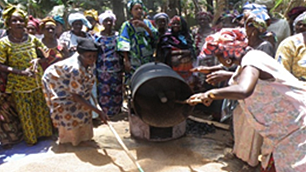
Training on improved rice parboiling - Guinea
Sierra Leone. As the National Center of Specialization of mangrove rice, Sierra Leone is on course to develop various new technologies in the areas of mangrove/riverine grassland soil fertility management, herbicide, adapted SRI (System of Rice Intensification), salinity tolerant rice varieties, and improved mangrove technologies, with the strong technical cooperation with Africa Rice Center.. Meanwhile PHRD financing supports the reconstruction, refurbishing and restocking of research facilities, and the training of a total of 10 young scientists (8 MSc./M.Phil and 2 PhD), with the first batch of MSc graduates expected by 2014. The project is also active at the field level and has benefitted more than 18,000 farmers with new varieties and more than 10,000 have adopted the new technologies made available under the project. Sierra Leone is also set to fly for the quality seed production with improvement of the stock of breeder and certified seed as well as reviewing seed certification system. Collaboration is also active not only with other WAAPP countries (SRI from Mali and CARGS process from Cote d’Ivoire) but also with other development partners such as JICA in scaling up the “technical package on rice production” developed under a JICA project.
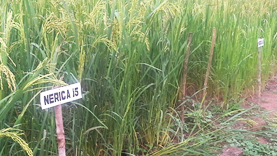
Multiplication of NERICA seeds – Sierra Leone
Liberia. The PHRD funding focuses on strengthening national research system capacities and funding of demand-driven technology generation and dissemination. In the former, rehabilitation and restructuring of the Central Agricultural Research Institute (CARI) is going on while Africa Rice Center is providing day-to-day training of the local researchers. In the latter, the project has produced 40 tons of foundation seeds and 400 tons of improved seeds that were distributed to over 39,000 farmers. For technology dissemination, improved rice varieties are demonstrated in four sites in the country while SRI is being piloted in two counties.
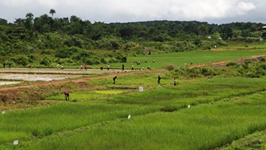
Trial field in CARI – Liberia
Côte d’Ivoire. The project has so far made a robust progress, benefitting more than 50,000 rice farmers (which is near 10% of domestic producers), of which 25% are women. Particularly quality seed production has made a remarkable contribution by covering 36% of irrigated rice areas for an expected 219,000 tons of paddy rice. A key enabling factor to this success was the restoration of the capacity of seed certification through refurnishing relevant equipment and human capacities. Additionally, rice research system has also been strengthened through rehabilitation of key research centers and schools and developing partnership with the national universities in executing research and extension projects. As a result, 11,000 producers have reportedly adopted improved technologies introduced by the project.
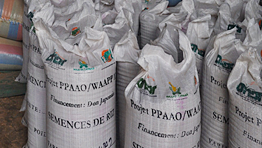
Bags of rice seeds – Côte d’Ivoire
Partners
Africa Rice Center (AfricaRice). AfricaRice is closely collaborating with WAAPP. Under an MOU with MRU countries Africa Rice has appointed two scientists to rebuild the research system in Liberia and Sierra Leone where the research has collapsed during the war as well as support seed multiplication. In addition Africa Rice is collaborating in all the WAAPP countries in the provision of breeder and foundation seed, capacity building and technical support.
Japan International Cooperation Agency (JICA). Since 2006, JICA has been operating a technical cooperation project called Sustainable Rice Development Project (SRDP) in Kambia District of Sierra Leone to develop technical packages of both upland and lowland rice that suit to the local agro-ecological and socio-economic conditions. The project has been implemented in collaboration with Rokupr Agricultural Research Center (RARC) which is also the designated NCoS for mangrove rice under WAAPP in Sierra Leone, and has successfully developed a package for nation-wide dissemination. Exchange of SRDP and WAAPP have started recently with extension staff of WAAPP Guinea and Sierra Leone participated an SRDP workshop which was funded by WAAPP Sierra Leone and JICA. WAAPP expects that the collaboration with SRDP for the MRU member countries will contribute to the upscaling of rice production technologies.
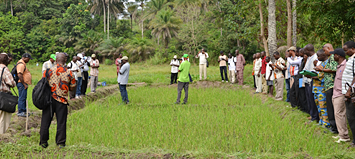
Field training WAAPP-JICA collaboration – Sierra Leone
Towards the future
The support provided by the World Bank and the Japanese Government through the PHRD grant to the countries of the Mano River Union sub-region has enabled them to increase their agricultural productivity and contributed towards the achievement of acceleration in the adoption of improved technologies. The project through the implementation of the various components has: revitalized seed production systems, increased area under cultivation and farmer adoption of new technologies and has also strengthened the agricultural research systems through short and long term training of young scientists and other categories of personnel.
In pursuance of the project development objective, WAAPP support for increase in rice production in the sub-region, will continue to consolidate the gains already achieved. Capacity building efforts, encompassing infrastructural construction and renovation and human resource development will be sustained. The training of young scientists will determine the quality and sustainability of programme progress. Scholarships will therefore continue to be provided at sub-regional and international levels to enable young scientists to embark on post graduate studies. Programme activities will be consistently geared towards scaling up operations through the adoption of best practices, in inclusive innovation platform execution, which will be the main vehicle for the dissemination and promotion of the adoption of new technologies. Actions will be pursued within the individual countries of the Mano River Union, as well as at the sub-regional level through the joint research and planning, technology transfer and shared learning experiences, through the continued pursuance of regional integration strategies.
At the same time, WAAPP support will have to ensure the sustainability of what has been achieved. It is true that many successful signs have been emerging, but these signs have to undergo rigorous assessment of institutional, economic and fiscal sustainability and take appropriate measures so that the fruits of the program will be sustained in the long term.
